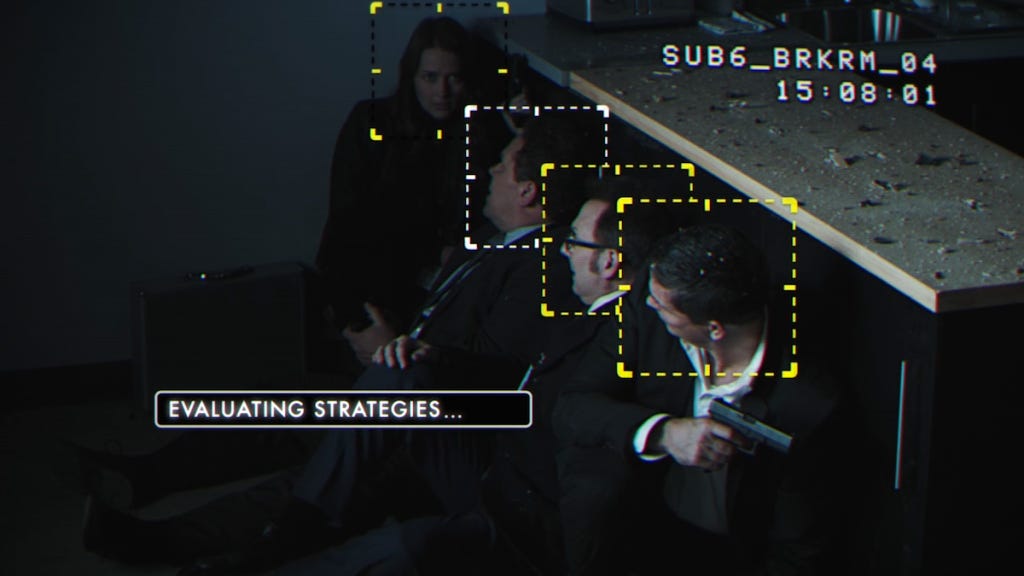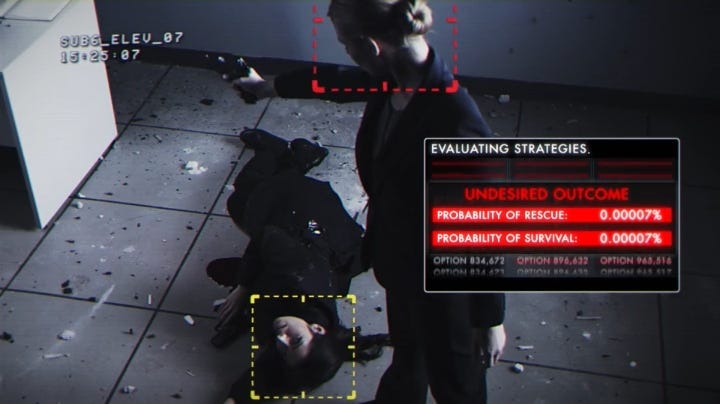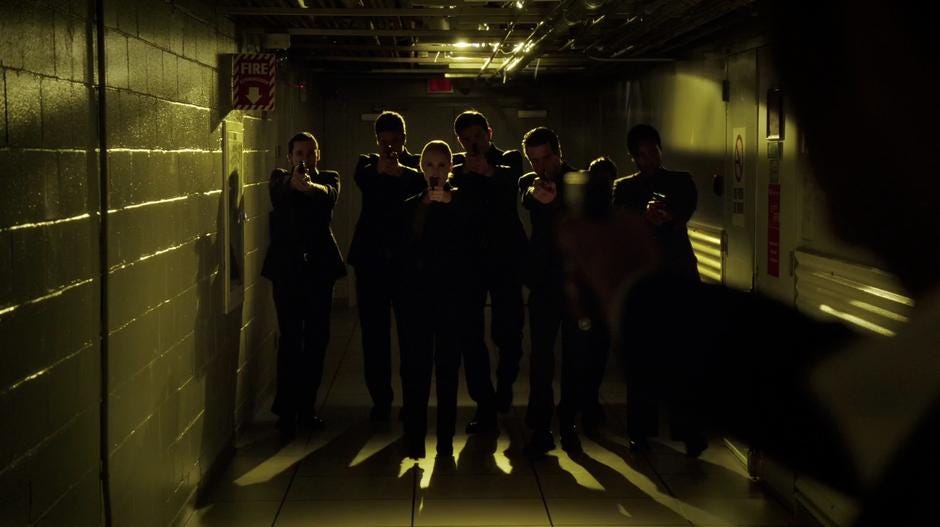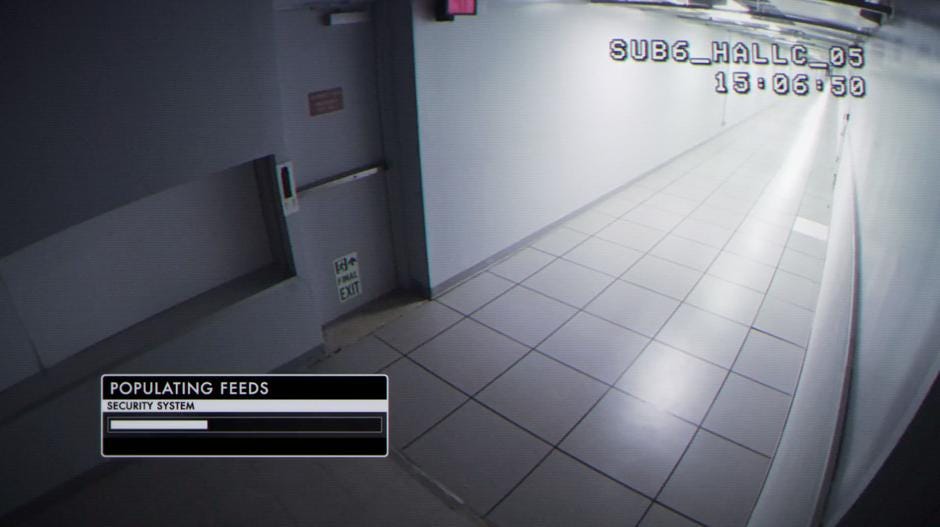Visual Themes in PERSON OF INTEREST “IF-THEN-ELSE”
Using set design, blocking, cinematography, repetition and deviation - basically everything - to visually illustrate key themes and motifs
Person of Interest‘s “If-Then-Else” functions somewhat as a short film: its ‘branching simulations’ form is unique within the series; it involves a core group of characters whose relationships are clearly delineated within the episode; the plot is a clear self-contained objective which is reached through repetition, trial and error.
But the episode is not a true standalone. The show’s themes, throughline, and canon are deeply relevant, a ‘personality’ aspect of The Machine emerges for the first time, and the plot takes a large step toward the show’s endgame.
To pack all that in 40 minutes requires plenty of shorthand: on the page whether in ‘big print’ or dialogue; in acting and how characters respond to each other physically and emotionally; in visuals including wardrobe, set design, fight choreography; in the way scenes are intercut, coloured, mixed, etc.
This episode requires ability to tell a tight story alongside extensive understanding of the series and characters as a whole. “If-Then-Else” tapped series EP Chris Fisher to direct, and we’re going to look at how his choices* for set design, lighting, blocking, framing, and dozens of other specifics work together to carry the story and motifs.
*begin Narrator aside
Though TV is slower than film to pin an episode’s success or failure on a director, if this episode’s gamble doesn’t work, Fisher would wear it.
“If-Then-Else” comes halfway through season four, so the crew knows Person of Interest inside out, and would have strong thoughts on these millions of tiny choices. While the episode’s final form can broadly be attributed to ‘the director,’ but it is always a team effort.
Often people think a director’s job is to tell people where to stand or “act sad harder,” but a billion more options and choices go into it. The bulk of a director’s job is not “have a vision!” but “bring together other highly-skilled people to tell a good story, clearly conveying its plot, stakes, emotions, themes, etc.”
To properly execute creative choices they must be determined beforehand, often by the director in conversation with showrunner (in this case, Chris Fisher himself) and DP; and with a TV show there’s already an established aesthetic and style to work with (or sometimes, break).
That “third time the script is written” is a great deal limited or enabled by what is shot, ie “If-Then-Else” contains several ultra-slow-mo shots which had to be shot at a specific frame rate. A bigger example is drastic colouring: desaturated flashback scenes; strong blues for many ‘current day’ scenes with Finch/Root/Fusco/Reese; more muted blue-and-yellow with their intersecting-sickly-green colours for Shaw until she gets to where Root is and joins her colour palette; etc. This is striking for its own sake, but helps the viewer quickly pick up on who they are with and when, especially as the episode starts getting more frenetic and intercutting more.
Just for that colour scheme to work: the set designer finds or builds the right set, wardrobe makes sure nothing clashes (though for Person of Interest the only real variation from “suits and black leather” is usually Finch), the DP lights and lens a certain way so the colourist can bring it all to life in post.
Clearly the episode’s look is more than ‘directorial choice,’ but a good director knows how to make the call within collaboration, putting many items in the stew while turning others away or suggesting changes from what’s presented by the team.
/ end Narrator aside
Now you’ve read that whole narrator aside, let’s talk about the outcome of such intense collaborative within “If-Then-Else”
Chess Setpieces!
Chess is a long-established Person of Interest touchstone which “If-Then-Else” emphasises in plot, dialogue, and most importantly for our purposes: visuals.
These three sequences play out with minor-yet-crucial differences, and combine elements mentioned earlier.
Set Design The floor is a chessboard with squares large enough for each character to stand in/on.
Lighting The saturated blue with one bolt of yellow from which our heroes emerge continues strong use of those main colours.
Blocking and Choreography While the actions might seem unnatural, they’re in keeping with Root making precise movements on the Machine’s recommendations, and most importantly reminiscent of chess patterns, where pieces move in straight lines, no curves.
Framing and Shooting We (the camera) are on a high enough angle to see the floor squares and how the ‘pieces’ move, but not so high the fight moves and gunshots are obscured.
Music The score (Ramin Djawadi killing it as usual) draws on both the show’s overall score and tinny tunes of early computer games, one of which was chess (and many of which Root plays when we see her as child elsewhere in the series.
Post Production These sequences involve editing (in and out is also an important edit!), colouring, scoring, sound mixing (take out Root’s distracting boot clacking, put in gunshot noises, emphasise the gun skittering across the floor, temper music levels around all those noises, etc), CGI (for muzzle flashes as well as probably dozens of little barely-noticeable bits), etc.
The sequences aren’t merely for flash and fun but to show-don’t-tell the episode’s main theme, quickly deviating from identical openings to spiral outwards into probabilities in the billions, just like chess games.
And they aren’t the only “If-Then-Else” shots reminiscent of a chessboard . . .
Many “If-Then-Else” elements clearly show this is a game with stakes and consequences, and those who think they’re the masters may actually be pawns.
One of my favourites is a simple shot where Harold is a piece on a chessboard made of chessboards; the camera moves up from a simple closeup to this high framing reminiscent of the angle the Machine has seen him from all episode:
I don’t know if anyone’s read this far without watching the show, but now is when I warn SO MANY SPOILERS in the remaining couple paragraphs
That ending high angle is very God’s eye view, visually underlining what the episode has been saying in many ways all along: The Machine can see all the pieces, knows what they’re doing and what will happen to them.
With this reminder, “If-Then-Else” hurtles towards the end scene, where Team Machine helplessly looking on as pawn Martine moves across a square to capture footsoldier Shaw.
The same floor squares which were used as ‘chessboard squares’ in the above sequences are shown again in this framing, as one piece vanquishes another.
Or rather, a piece who made a choice to sacrifice herself, as The Machine / Chess Grandmaster knew would happen all along.
It’s not as clearly exposited as this iconic “TV show uses chess to spell out its core themes” scene, but “If-Then-Else” extends the game to make a whole 40 minute episode a chess game, using dialogue, plot, and most especially visuals to bring the analogy to life (and death).
At its core, Person of Interest argues that every number matters, and nobody is more important that anyone else: we’re all queens. But it also consistently and not at all contradictorily demonstrates the world treats some people like pawns, others kings, others knights, etc.
Though the ‘powers that be’ of fate and government and chance and more push us across the board, we each have a say in what kind of piece we are, and how our lives impact others.
In script as well as precise visuals, “If-Then-Else” is a climactic episode demonstrating this thesis.









